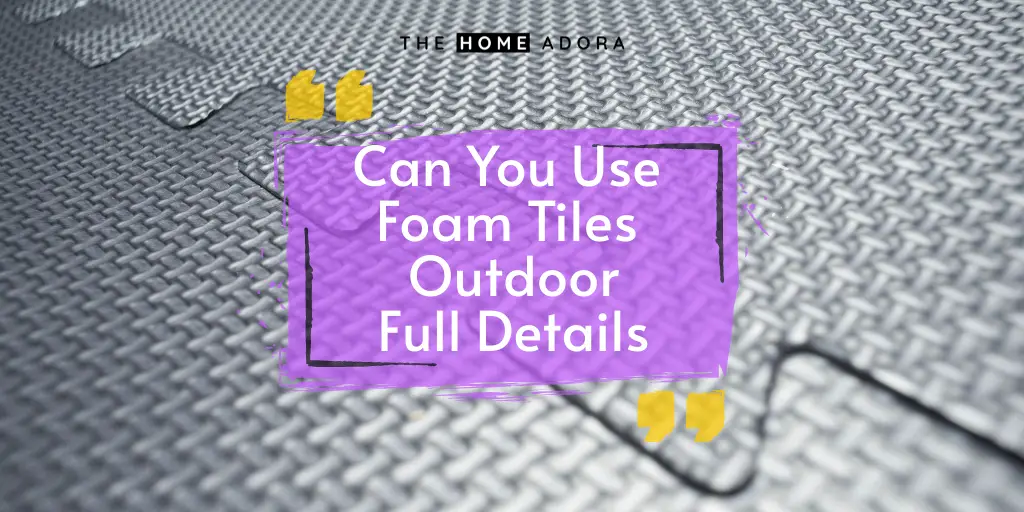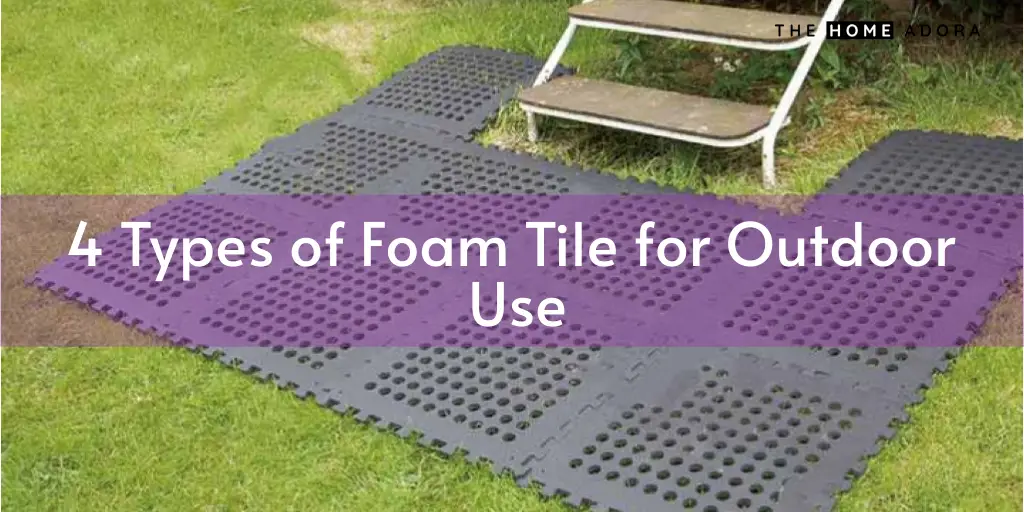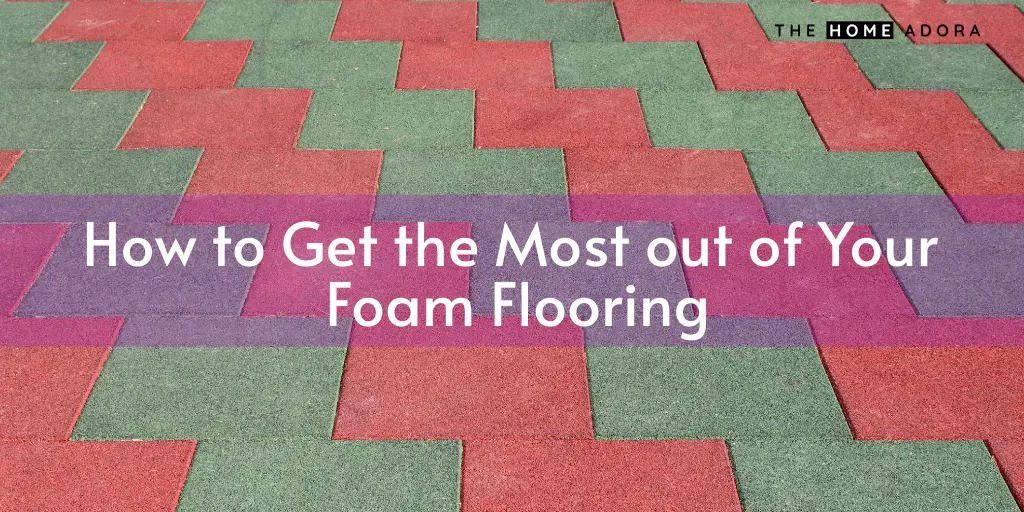When considering outdoor flooring, you may or may not consider foam options. Some are only meant for indoor or temporary outdoor use, while others are meant for permanent outdoor use. Outdoor foam tiles comes in a different shapes & size, and we’ve compiled a list of the best available options.

Can I Use Foam Tiles Outdoor
Yes!. Foam Tiles can be Used Outdoors while some are only meant for indoor or temporary outdoor use.
4 Types of Foam Tile for Outdoor Use

#1. Foam Slate Tiles
Presumably you prefer a high-end appearance of slate. If so, the 3/8 inch thick Floor Slate Tile is an outdoor foam tile solution. This exterior floor is made of PE/EVA foam and rubber materials, resulting in a visually appealing floor that is UV stable, slip resistant, durable, long lasting, and available in a variety of colors. This tile is ideal for any area that is frequently exposed to water, such as a pool or hot tub, an outdoor bar area, or an outdoor deck or patio. Because of its grippy slate top texture, this outdoor foam tile provides a high level of cushion and traction. It is non-toxic, UV-resistant, long-lasting, soft, and slip-resistant. It also has a critical fall height of one foot.
#2. High Traction Foam Tiles
These outdoor foam tiles are ideal for use in any area where children will be running and playing in a wet area, such as a children’s splash pad, hot tub surround, or waterpark play area. This 38-inch-thick product is commercially rated for water parks and splash pads and meets NSF safety standards for wet surfaces. It is also ASTM fall height rated (1 foot), antimicrobial, and UV resistant, ensuring that it always looks great in the sun.
This is a non-slip, soft flooring option. The ripple surface texture provides superior traction, making this outdoor foam tile an excellent choice for any wet area such as a locker room, swimming pool deck, shower area, or any other location where a safe flooring solution is required. This soft flooring is simple to install and maintain. It will work perfectly in any wet outdoor space.
If you’re worried about your deck getting too hot in the middle of summer, this product might be worth considering. In hot weather and with indirect light, this outdoor flooring option provides footing that is cooler to the touch. When stepped on, the temperature stable tiles quickly cool down!
Because they are anti-microbial and non-toxic, these soft tiles are frequently used in public pools and other shared wet areas. They have a super grip, ripple surface texture that greatly reduces the possibility of a slip and fall. The tiles are made of closed cell foam and rubber, providing a soft flooring solution that combines comfort, durability, and safety. They come in a variety of colors.
#3. Outdoor Playground Foam Padding
If you’re looking for flooring for a playground, these thick Foam Padded outdoor tiles are an excellent choice. It is a 4×5 foot pad that is 2 inches thick. This impact-absorbing padding creates a soft and secure environment beneath artificial turf. It is non-microbial and has a long lifespan with no decay, deformation, mold, or fungus growth. This item is made entirely of recycled, non-contaminated, post-industrial, cross-linked closed cell polyethylene foam. It creates a very safe and resilient playground that combines quality and value, has a 9 foot fall rating, and is a Next Generation Playground Product when combined with playground turf.
A 1 inch version of the playground foam padding is also available. This underlayment, like the 2 inch, provides a high level of softness to artificial playground turf. When combined with turf, this product is certified to a 5-foot fall height rating, making it an excellent choice for use near playground equipment.
At less than $2 per square foot, this playground foam pad is both inexpensive and dependable.
#4. Carpet Tiles with a Foam Backing
Finally, if you need carpeted outdoor foam tiles, this Royal Interlocking Carpet Tile is an excellent choice. This carpet tile is a popular product for boats, porches, and other applications because it can be quickly and easily removed and reinstalled, and it can be installed directly over almost any solid surface due to its interlock design. They have the same anti-fatigue and insulating properties as traditional carpet, and they are waterproof and odor proof. These foam-backed carpet tiles are easily cleaned by vacuuming, and because they do not absorb water, they can be stood on end to dry if they become wet. This product is available in a variety of colors other than black.
How to Get the Most out of Your Foam Flooring
With so many applications for mats in your home, such as playrooms, bedrooms, and home gyms, it’s easy to see why interlocking EVA foam flooring is sweeping the country.

However, while we love EVA foam mats for their versatility, anti-fatigue, and low-impact properties, they require different care. We’ve compiled a list of tips to help you extend the life of your EVA foam flooring.
- Reduce friction on the bottom and interlocking points between tiles to prevent the mats from sliding by placing them on surfaces such as concrete, tile, or hardwood floors; holding them in place with double-sided tape only improves this.
- Avoid sharp object pressure: While EVA foam is dense and durable for everyday use, sharp corners from heavy furniture, standing in high heels, and the claws of certain pets can scratch the surface of your mats.
- Clean your mats frequently: Wipe down your mats with soap and water on a regular basis to keep them free of unpleasant dust. However, cleaning procedures differ depending on the type of mat you have.
How To Install Outdoor Foam Tiles (Video Reference)
Frequently Asked Questions (FAQs)
How do you keep Outdoor foam tiles together
To keep the mats from shifting or sliding apart, double-sided tape can be used to secure them to the subfloor in some cases. However, in most cases, you’ll want to tape or connect the mats together at the surface. Tape can be used to keep vinyl-topped foam roll out mats together.
Conclusion
In conclusion, foam tiles can be used outdoors, but they may not last as long as when used indoors. Try them out in a covered area first to see how they hold up. If you have any success (or failure) using foam tiles outdoors, please leave a comment and share your experience.

